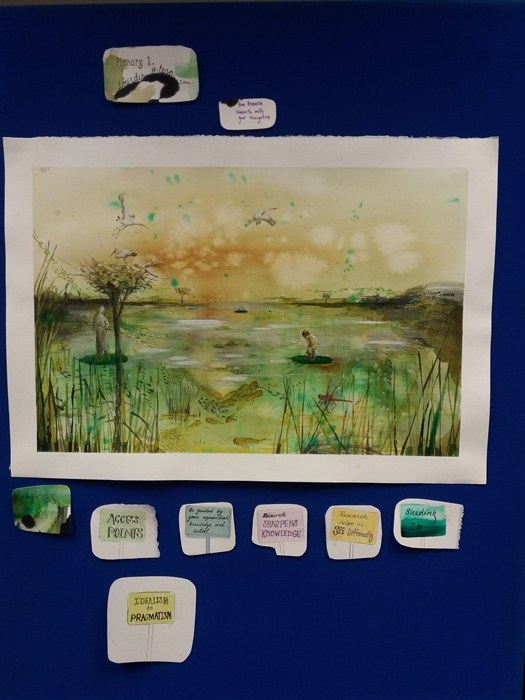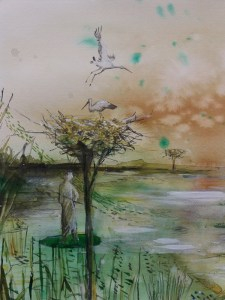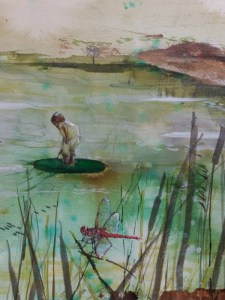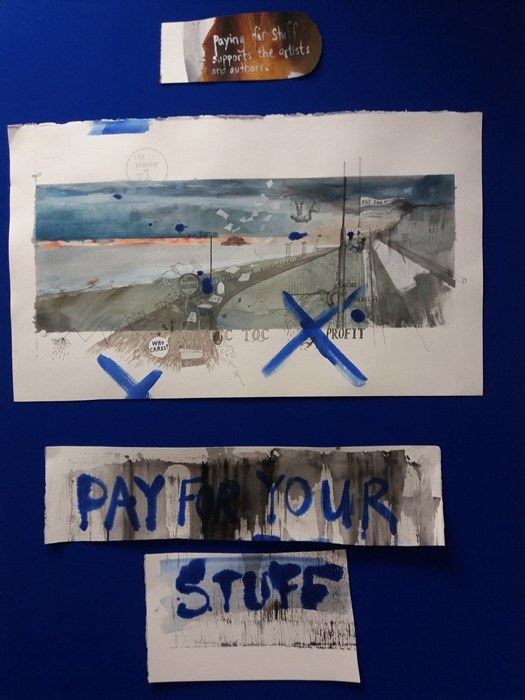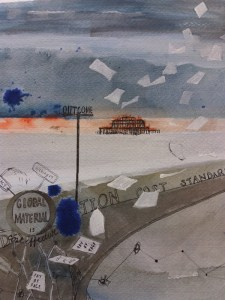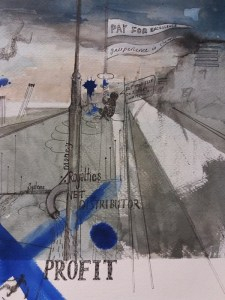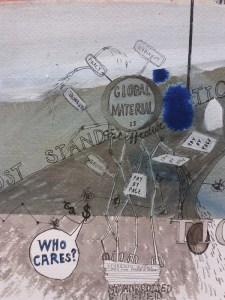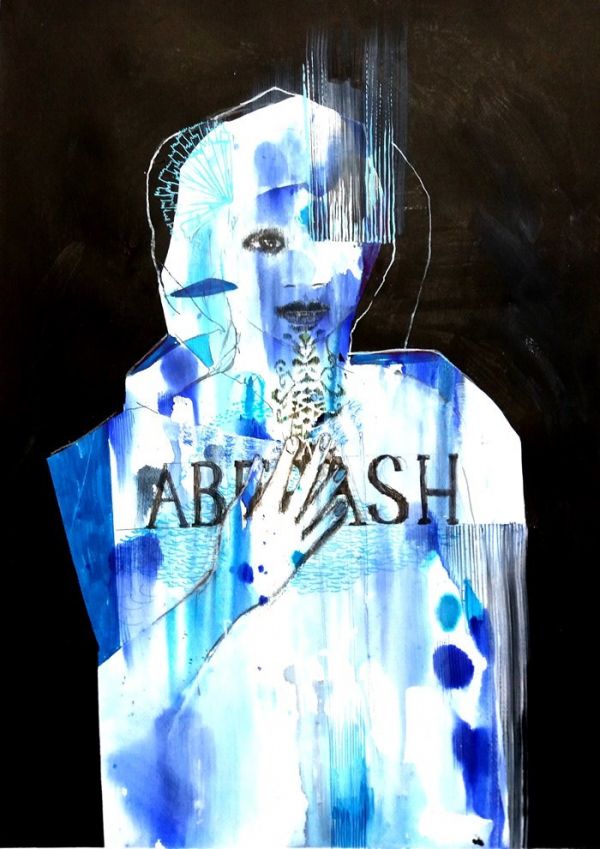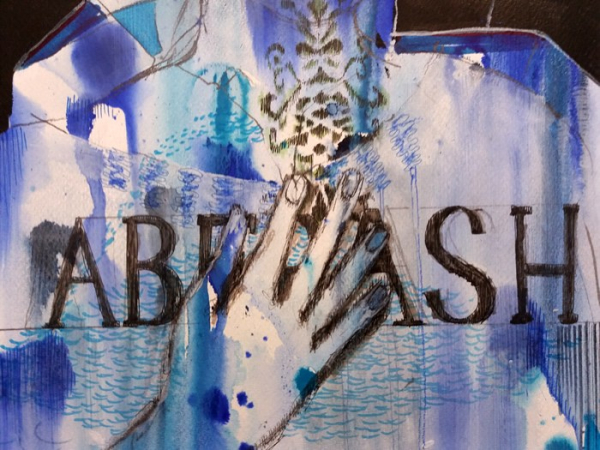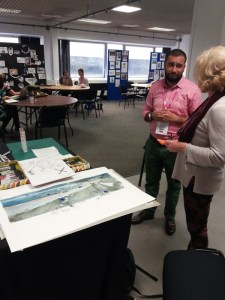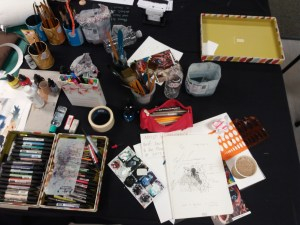When I was invited to be the artist in residence at IATEFL in Brighton this year, I jumped at the chance. I had already been talking about artists’ residencies in learning and especially language learning contexts, and I was keen to develop my own practice and build on my knowledge from having coordinated artists in schools in New Zealand.
I had also been invited to participate in the Visual Arts Circle’s facilitation of the Global Issues SIG Pre-Conference Event. This was an opportunity to explore workshop as performance; an artwork in itself.
At the PCE, I used video and storytelling to lead delegates into a space where they were invited to express their own personal thoughts and stories visually on the theme of social justice. Over the four days of the main conference I made work that responded to the plenary speakers.
IATEFL Conference Day One
Lourdes Ortega, a Professor in the Department of Linguistics at Georgetown University, presented her ideas about the relationships of research and the classroom. How does a southern Spanish wetland ecosystem in spring relate to a presentation on research and the classroom? Listening to Lourdes, who originates from Spain, got me thinking about how the relationship between the classroom and research is like ecosystems within ecosystems. The classroom is one, education systems another, academic research another. Perhaps we could see it metaphorically as the wetland. The pond is teaming with life. There is the perspectives one gets from under the water, or if one is on the surface of the water looking in, or up, or from flying above it. Wetland dwellers never see all perspectives, just as teachers don’t always see their classroom within a wider context or how research might interact with their teaching and with learning. Suspended between the water and air worlds on their lily pads, researchers aren’t participators in the everyday of the classroom ecosystem, or the education system it is part of. They are outside of it, which is a disadvantage. However research can present different perspectives otherwise unseen.
Day Two
ELT writer Dorothy Zemach gave us an entertaining break down of the publishing world of ELT and what it’s like to currently work in it. I had already decided the setting for the content of this presentation, having finally made it outside at about 7pm the evening before to get some fresh air and sit on the beach in the dying light of the day.
Brighton beach was going to have to make an appearance. But as I listened and made notes, I was overwhelmed by the grey grubbiness of it all. The numbers game, the bottom lines and the need for everyone involved to have their financial needs met. As an educator and an artist, I felt very deeply for her plea to everyone to pay for the work of writers in our field. Paying well for good work ensures that the work continues to be good. However, that means someone down the line has to pay for it, and not everyone can.
Day Three
Brita Fernandez Schmidt is an advocate and promoter of women’s empowerment, women’s rights and equality. At the end of her presentation, I made my way out to the foyer of the Brighton Centre to catch delegates as they made their way in. I recorded short audios of their reactions to the speaker. Many were overwhelmed, motivated and inspired.
Later while making the work, I began talking to delegates who felt very differently about the presentation. They felt that it was emotionally manipulative and a call to action from a charity, and that the IATEFL conference wasn’t the place for that. This image is a made-up woman. Pieced together, or slightly reconstructed. If you were at the plenary, you would have noticed a gesture the speaker used a lot – that of her hand to her chest. So, I put her hand there and the name of the girl who moved her to action.
Slow Digestion
My temporary art studio, with its work in progress provided chance for reflection. I only had one plenary to digest slowly for the day. Meanwhile, others dashed about in front of me, often asking me hurriedly if room 11 was anywhere near. Conferences cause a sense of rush. We often need to “doggy bag” our thoughts and reactions, in order to sit down at the next meal. One workshop or presentation after another blurs into a degustation menu that is presented too fast, the plates taken away to suddenly.
I, on the other hand, had the space to slow it all down. People could, and did, come and pull up a chair and chat with me as I worked or wandered about the visual work I was creating and peer over my shoulder. I noticed during the GISIG pre-conference day that the room had fallen silent while people played with the dark ink and water on watercolour paper in the first playful stage of our workshop. I had expected chatter, but what I found was silence. A silent room. One delegate described it as if the act of watching the ink absorb in the paper made our bodies and minds slow down too. Perhaps we could consider more space for that in future conferences.
Emma L Pratt is a practising artist (www.emmapratt.com) with a degree in Fine Arts, a post-graduate in Museology. Her research interest is in the area of teaching artists and citizen artists, as well as the visual arts in learning. She is currently working on an Artists in Schools action research project developing visual work in a primary school and working on parallel workshops for learning and the visual arts. She is the Co-Founder and Co-Director of Frameworks Education Group that specialises in teacher development. She also is the developer of the 2016 ELTons nominated TEFL Preparation Course and Teaching English to Young Learners on ELTCampus, an online platform she also founded and developed.

